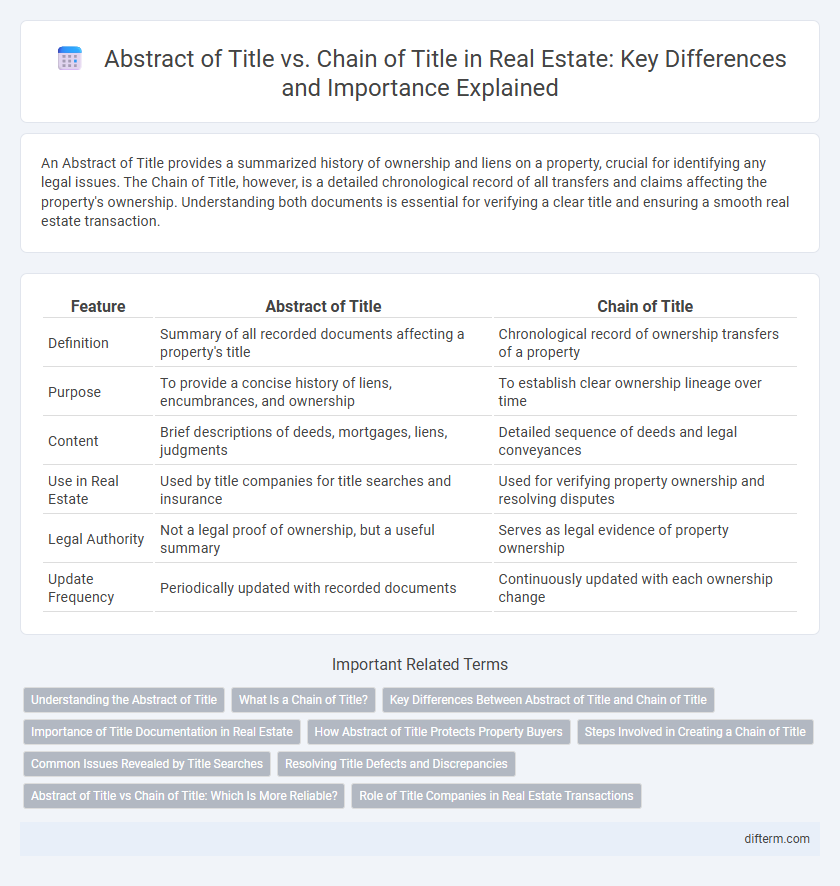An Abstract of Title provides a summarized history of ownership and liens on a property, crucial for identifying any legal issues. The Chain of Title, however, is a detailed chronological record of all transfers and claims affecting the property's ownership. Understanding both documents is essential for verifying a clear title and ensuring a smooth real estate transaction.
Table of Comparison
| Feature | Abstract of Title | Chain of Title |
|---|---|---|
| Definition | Summary of all recorded documents affecting a property's title | Chronological record of ownership transfers of a property |
| Purpose | To provide a concise history of liens, encumbrances, and ownership | To establish clear ownership lineage over time |
| Content | Brief descriptions of deeds, mortgages, liens, judgments | Detailed sequence of deeds and legal conveyances |
| Use in Real Estate | Used by title companies for title searches and insurance | Used for verifying property ownership and resolving disputes |
| Legal Authority | Not a legal proof of ownership, but a useful summary | Serves as legal evidence of property ownership |
| Update Frequency | Periodically updated with recorded documents | Continuously updated with each ownership change |
Understanding the Abstract of Title
The Abstract of Title is a condensed history of all recorded transactions and legal proceedings affecting a property, providing a comprehensive summary of ownership and encumbrances. It serves as a crucial document for verifying clear title and identifying liens, easements, or claims before property transfer. Unlike the Chain of Title, which lists documented owners in chronological order, the Abstract of Title consolidates this information into a digestible, legally relevant overview essential for real estate transactions.
What Is a Chain of Title?
A Chain of Title is a chronological record of all the legal documents that prove ownership of a property from the original owner to the current holder. It includes deeds, mortgages, wills, and court judgments that establish the property's transfer history and ensure clear ownership. Verifying the Chain of Title is crucial in real estate transactions to prevent ownership disputes and title defects.
Key Differences Between Abstract of Title and Chain of Title
Abstract of Title provides a summarized history of all recorded documents and legal actions affecting a property's ownership, while Chain of Title traces the sequential ownership transfers from the original grant to the current owner. The Abstract of Title serves as a condensed report for title insurance and legal review, whereas the Chain of Title emphasizes the continuity and legitimacy of ownership over time. Key differences include the Abstract's comprehensive document compilation versus the Chain's focus on chronological ownership lineage.
Importance of Title Documentation in Real Estate
Title documentation is crucial in real estate to verify legal ownership and protect against disputes or fraudulent claims. An Abstract of Title provides a summarized history of property ownership and recorded liens, while the Chain of Title traces the sequential transfer of ownership over time. Accurate and comprehensive title records ensure clear property rights, facilitating secure transactions and financing.
How Abstract of Title Protects Property Buyers
An Abstract of Title provides a condensed history of all recorded ownership transfers, liens, and encumbrances on a property, allowing buyers to verify clear ownership and uncover potential legal issues before purchase. By summarizing legal documents and public records, the Abstract of Title helps prevent disputes related to title defects, ensuring the buyer receives marketable title. This thorough examination protects property buyers from hidden claims, liens, or adverse interests that could jeopardize their investment.
Steps Involved in Creating a Chain of Title
Creating a chain of title involves systematically compiling every deed, mortgage, lien, and legal document associated with a property to establish a complete chronological history of ownership. Each step requires meticulous verification of public records, including grants, transfers, and encumbrances, to ensure accuracy and identify any gaps or defects. This comprehensive process is crucial for preventing title disputes and confirming the property's clear legal status before any transaction.
Common Issues Revealed by Title Searches
Common issues revealed by title searches include unresolved liens, encroachments, and errors in property descriptions found in both Abstracts of Title and Chains of Title. Gaps in ownership history or missing documentation can create clouds on the title, leading to potential legal disputes. Title searches uncover these defects to ensure clear ownership and facilitate smooth property transactions.
Resolving Title Defects and Discrepancies
An Abstract of Title summarizes the legal history and recorded documents affecting a property, providing a foundation for identifying potential title defects and discrepancies. The Chain of Title traces the chronological ownership transfers, essential for pinpointing breaks or irregularities in ownership that could impact the property's marketability. Resolving title defects often requires thorough examination of both the abstract and chain to ensure clear, marketable title for real estate transactions.
Abstract of Title vs Chain of Title: Which Is More Reliable?
An Abstract of Title summarizes the legal history of a property, providing a concise report of transfers, liens, and encumbrances, while a Chain of Title details the sequential ownership records, tracking the property's lineage through deeds and documents. Abstracts of Title offer a verified overview prepared by a title company or attorney, making them more reliable for establishing clear ownership and uncovering potential issues. The Chain of Title, though thorough, may contain gaps or errors, so Abstracts of Title are typically preferred for accuracy in legal and real estate transactions.
Role of Title Companies in Real Estate Transactions
Title companies play a crucial role in real estate transactions by providing both the abstract of title and chain of title, ensuring a clear ownership history. The abstract of title offers a summarized history of all recorded liens and encumbrances, while the chain of title traces the sequential transfer of ownership. These services protect buyers and lenders from potential legal disputes by verifying the property's legal status before closing.
Abstract of Title vs Chain of Title Infographic

 difterm.com
difterm.com